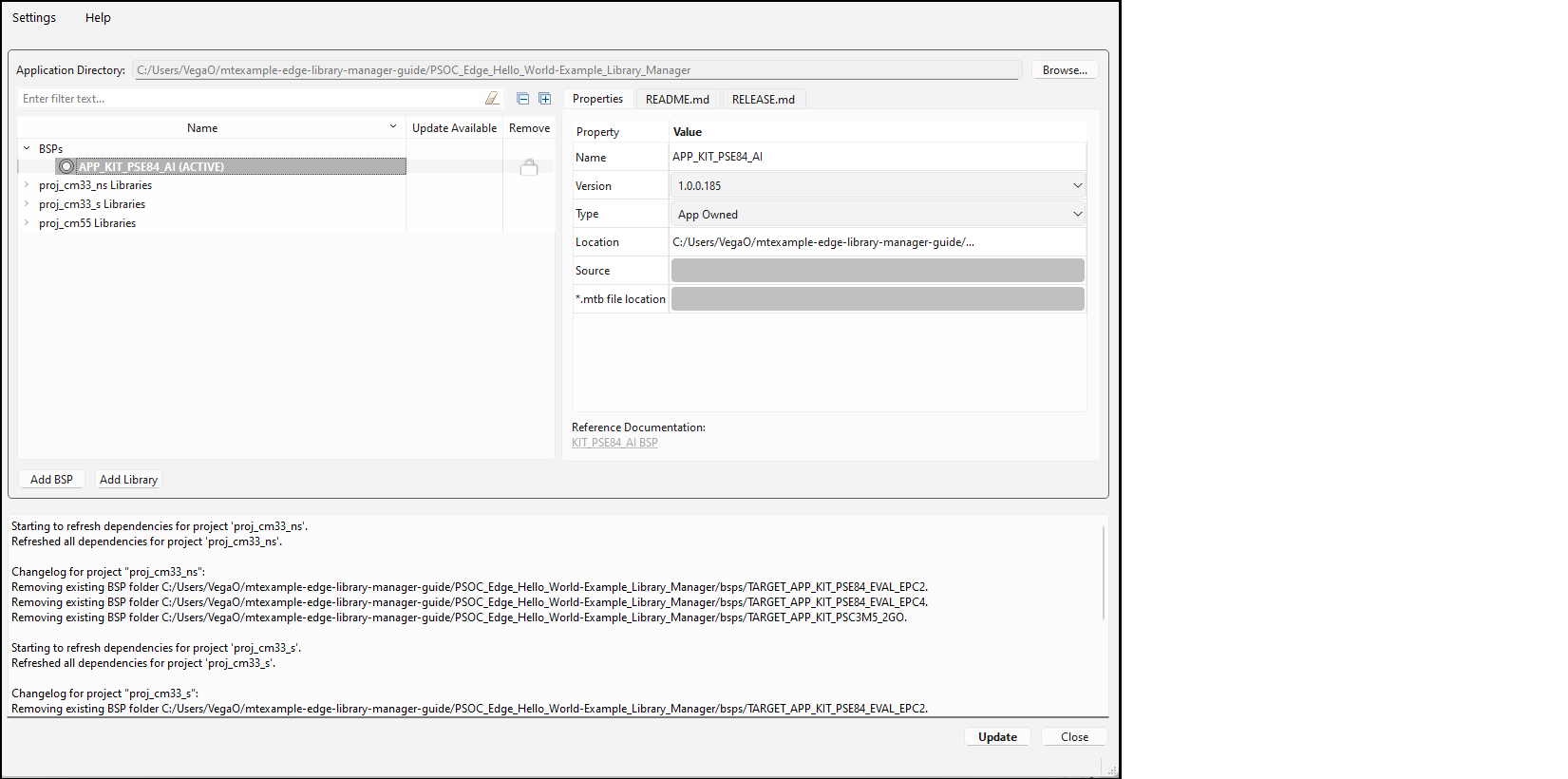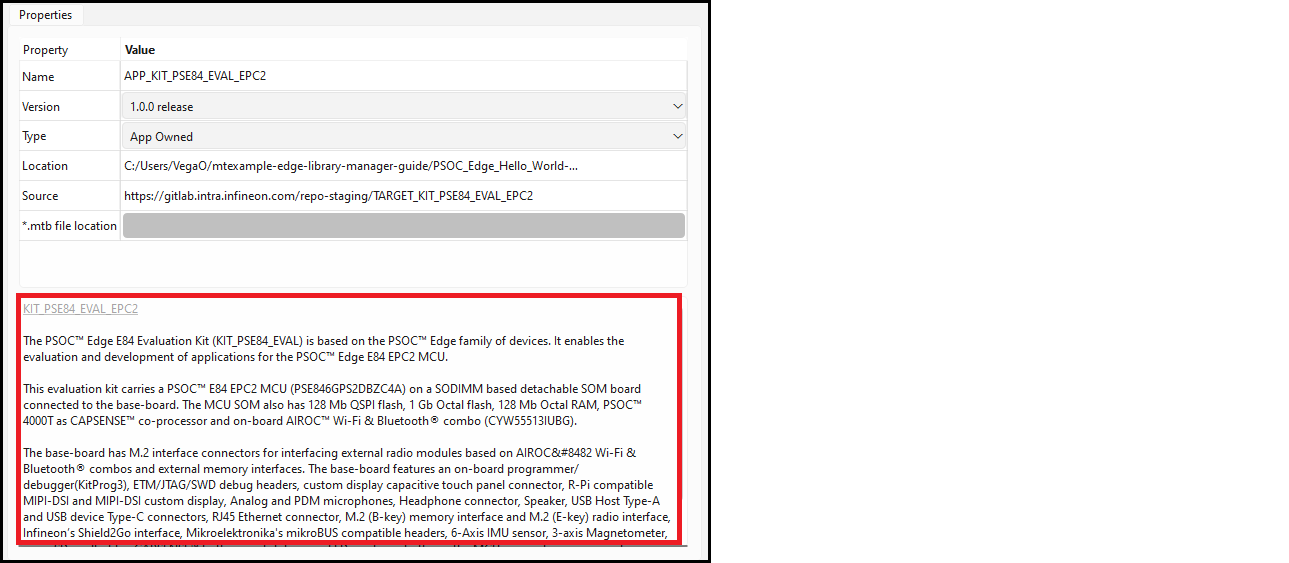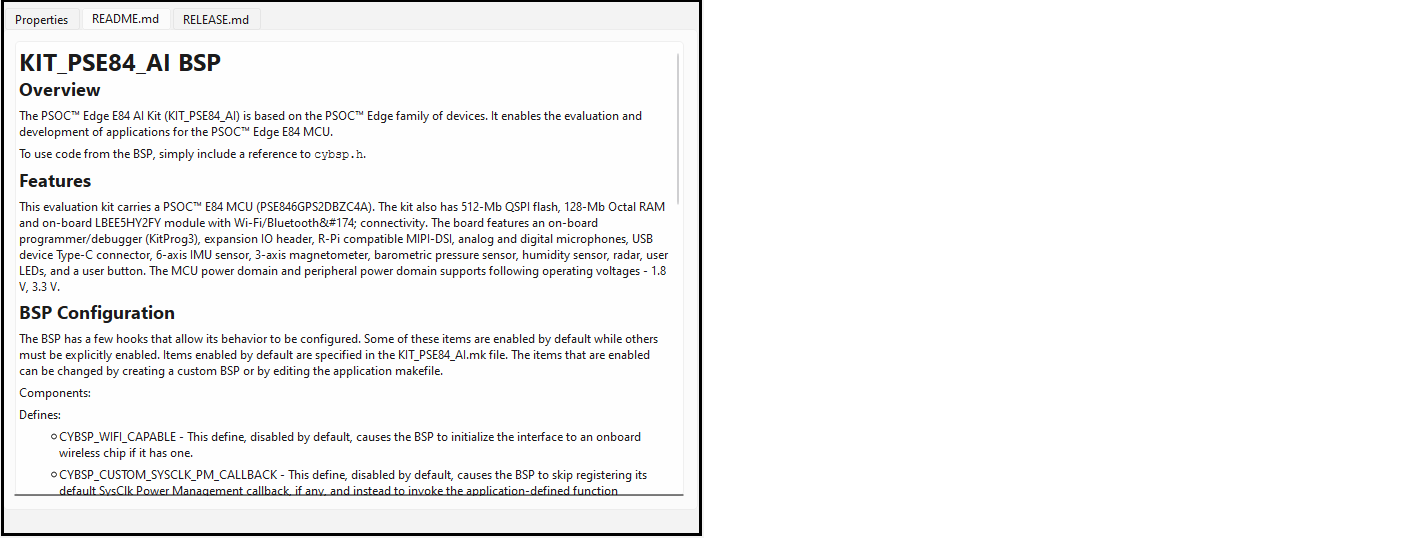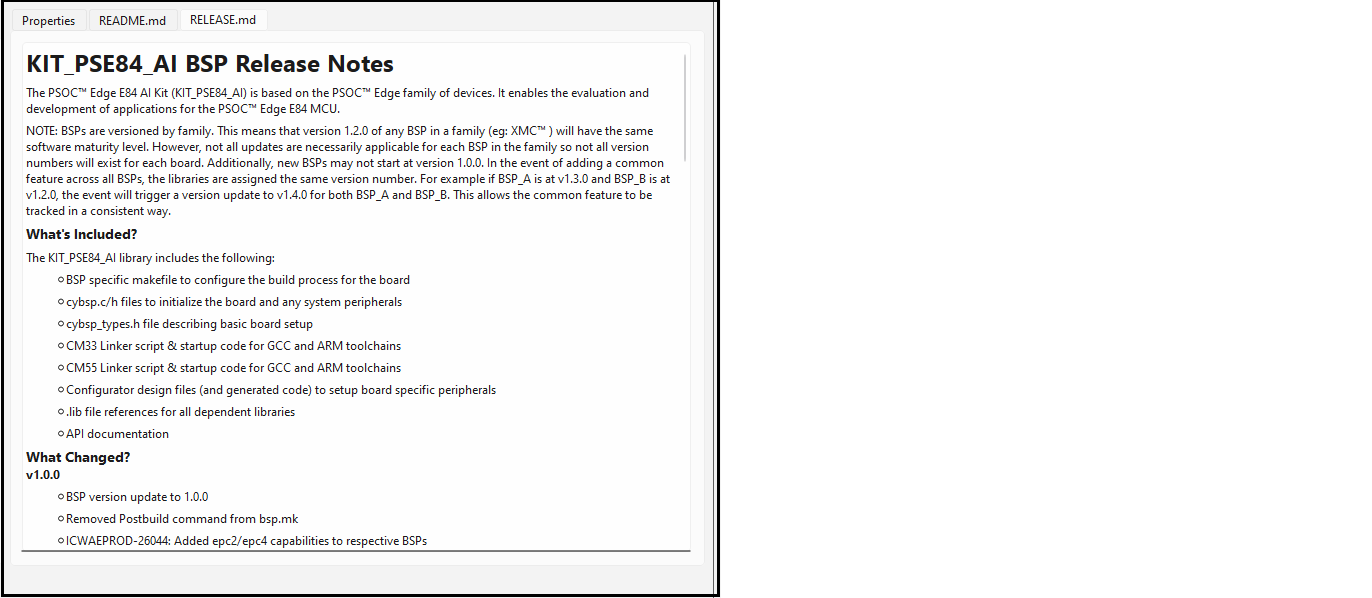GUI description
The Library Manager contains menus, controls, tabs and buttons used to manage BSPs and libraries.

Menus
The Library Manager has two menus, as follows:
Settings –
ModusToolbox™ Settings: : This opens the Settings tool, an editor that allows you to configure a wide range of settings for your environment, such as proxy settings, content modes, and manifest DB settings. See the Settings tool user guide for more details on specific features.
Help –
View Help : Opens this document.
About : Displays tool version information, with a link to open Infineon.com.
Application directory
This is the location of the application's top-level directory, which contains one or more ModusToolbox™ Makefile projects. Use the
Browse…
button to select a different directory, if needed.
BSP/library controls
The left side of the Library Manager contains various controls for managing BSPs and libraries:
Filter text – Field used to show only the BSPs/libraries that match the text entered.
Collapse All – Click to collapse all item trees.
Expand All – Click to expand all item trees.
Remove Library – This button allows you to remove libraries from the application.
Add BSP – This button allows you to add and import BSPs to the application.
Add Library – This button allows you to add libraries to the application.
BSP context menus
If you right-click on a BSP, different commands are available. See "Working with BSPs" for details.

Set as Active BSP – This button allows you to switch between multiple BSPs, choosing which BSP is active and non-active.
Rename BSP – This button allows you to specify the name for a BSP created as an in-app BSP.
Remove BSP – This button allows you to delete a non-active BSP.
Tabs
The right side of the Library Manager contains the following tabs for a BSP or library:
Properties
,
README.md
, and
RELEASE.md
. Each tab may contain links to reference documentation that you can follow to find more specific information about your selected BSP or library.
Properties tab
The
Properties
tab contains several fields of information about the selected BSP or library.
Name
The
Name
field contains the BSP or library name. For BSPs, this field can be changed. See
Rename BSP
for more information on how to use the feature.
Version
The
Version
field doesn't apply to version 3.x BSPs, which are owned by the application. If this field is populated, it just displays information from the JSON file.
For all libraries and 2.x BSPs, you can select a dynamic "Latest X.Y release" or a fixed "X.Y.Z release" version. These represent tags for versions of libraries and version 2.x BSPs in GitHub repos:
Dynamic – If you select a "Latest X.Y release " version, then it is dynamic. A ModusToolbox™ v2.x application will download and use the appropriate version specified in the manifest and attempt to resolve any potential conflicts with different versions. Using a "Latest" version means the item will update to the latest, backward-compatible version whenever you click the Library Manager Update button.
Fixed – By selecting a specific "release-vX.Y.Z" version, you assign a fixed version of a specific, official release of the item that does not change, unless you manually change it.
When you create a new version 3.x application from an Infineon code example, the application converts libraries to use the "X.Y.Z release" version, by default. This ensures that they will not be updated automatically, unless you change the version to "Latest X.Y release."
When you open the Library Manager for an application and make any kind of change, the change summary displays in the console. If a "latest-vX.Y" tag has a newer version, the console displays a warning about the "latest-vX.Y" tag. It includes a hyperlink to open a dialog that explains how the "latest-vX.Y" tag auto-update works.
If you click
Update
, all items with the "latest-vX.Y" tag will be moved to the newer version, even if you didn’t make changes to them.
Type
The
Type
field doesn't apply to version 3.x BSPs. All 3.x BSPs are owned by the application.
For all libraries and 2.x BSPs, this field contains a pull-down menu to specify if the selected library is shared or local. See
Specifying dependencies
for descriptions of shared and local.
Location
This shows the current location on disk for the selected BSP or library.
Source
This field doesn't apply to version 3.x BSPs. It shows the source location (usually on GitHub) for the library or version 2.x BSP.
MTB file location
This field doesn't apply to version 3.x BSPs. It shows the location on disk for library and version 2.x BSP .mtb files.
Description
For most libraries, there is a brief description included below the table.

README.md tab
This tab displays the
README.md
file for the selected BSP or library, if available.

RELEASE.md tab
This tab displays the
RELEASE.md
file for the selected BSP or library, if available.

Buttons
The Library Manager contains the following buttons to perform the described actions:
Update
– Use this button to update your project with changes made in the Library Manager. This action runs the
make getlibscommand and you can use it at any time, even if you made no changes. You might do this for a project that has no libraries yet, or to update the libraries specified as "Latest" to get any updates. This button becomes bolded when there are pending changes requiring an update.Close – Use this button to close the Library Manager.
Retry – This button displays if the message console indicates that the tool cannot access the manifest file. Use the
Retry
button after adjusting your internet and/or proxy settings to check if the tool can access the manifest file.
Message console
The area below the BSPs and Libraries displays various messages, such as when you select/deselect an item, click a button, or select Local Content mode.